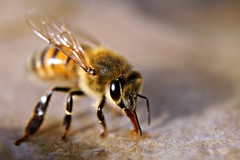 |
| Bee Happy (Photo credit: Treesha Duncan) |
The controversial ban on neonicotinoid insecticides comes into effect across the EU this weekend.
Neonicotinoids, or neonics, are powerful neurotoxins, killing insects with minute doses and impairing their behaviour at much lower doses still.
This is desirable when the insect is a pest, not so good when it is a useful bee.
The origins of the ban lie in a series of scientific papers showing the doses bees are likely to receive in the field are enough to cause them significant harm, either killing them outright or interfering with their otherwise phenomenally impressive navigation and learning skills.
As a result of these papers, the EU asked the European Food Standards Agency to conduct a review of the safety of these chemicals for bees. After a six-month review by a team of experts they concluded in January 2013 that neonics pose an “unacceptable risk” to bees. Hence the moratorium.
The UK fought tooth and nail against this decision, siding with the agrochemical industry who claim the science is flawed. But eventually the moratorium was passed with 15 countries voting for and eight against.
Hurrah for the bees! Or perhaps not. As I describe in A Sting in the Tale, the big picture is that pesticides are far from the only problem bees face.
They have been declining for decades, with a loss of flowers and nesting habitats the biggest cause. Modern intensive farming generally leaves little room for bees or other wildlife.
On top of that, humans have foolishly spread bee diseases around the globe, so they are now suffering from foreign parasites and infections that they have little resistance to. Exposure to pesticides such as neonics may sometimes be the final straw that pushes them over the edge to oblivion.
Removing the pesticides is not going to result in booming bee populations; they will still be hungry and diseased.
In any case, bees will still be exposed to neonics, even with the moratorium. For starters, next year’s crops are already infused with them and the moratorium will only really begin to kick in in 2015. This is the same year that the moratorium expires, so there is precious little time to see any benefit.
The moratorium only applies to flowering crops and crops sown in the spring and summer, so neonics will continue to be widely used on winter wheat, for example.
They will also still be sprayed in private gardens and horticulture, because the moratorium only applies to the types of neonic used as seed dressings.
Finally, and perhaps most significantly, we know that neonics persist in the environment for years - so even if we stopped using them completely, it would be a long while before we saw any benefit.
Many of us agree that the two-year moratorium was better than nothing, but it is clearly not a definitive solution.
No programme of funding for further research after the two year period following the ban has been proposed by the EU. No monitoring of wild bee populations is planned either, so in the unlikely event that their numbers do increase in 2015 we won’t know about it.
At which point the agri-chemical industry is likely to declare that the moratorium has achieved nothing measurable and that therefore it should lapse.
Of course this would not be a fair interpretation of the facts, but it is an argument that will certainly appeal to our current government, and which might prevail.
Whatever the final outcome of the neonic debate, some of us would argue that there are some fundamental structural issues with the way that farming is carried out that need to be addressed.
In the UK, many agronomists are employed by agrochemical companies. There are precious few sources of independent advice for farmers.
When I was at university nearly 30 years ago, I was taught that Integrated Pest Management (IPM), a system predicated on minimising pesticide use, was the only farming system that was sustainable in the long term.
Under a new EU directive, European farmers are all supposed to use the system from January 2014. But as far as I can see, current arable farming has abandoned all the IPM principles in favour of maximising yield at all costs.
Until this issue of the unsustainable overuse of virulent poisons is tackled, it is hard to imagine our countryside becoming a much better place for bees, or any other wildlife.
Dave Goulson receives funding from Defra to study the impacts of exposure of wild bumblebees to neonicotinoids and a grant from BBSRC that starts next year, focussed on trying to improve our understanding of the impacts of neonics on both honeybees and bumblebees.
This article was originally published at The Conversation. Read the original article.

No comments:
Post a Comment